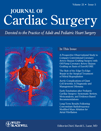Can Intraoperative Motor-Evoked Potentials Predict All the Spinal Cord Ischemia During Moderate Hypothermic Beating Heart Descending Thoracic or Thoraco-Abdominal Aortic Surgery?
Conflict of interest: None
Abstract
Abstract Background and aim of the study: Paraplegia is a serious complication of descending thoracic or thoraco-abdominal aortic aneurysm (DTAA or TAAA, respectively) surgery. The functional integrity of the spinal cord can be monitored with intraoperative motor-evoked potentials (MEPs). Herein, we evaluated the results and adequacy of MEP monitoring. Methods and Results: Between March 2006 and April 2009, 33 patients (24 males and 9 females) were monitored with MEPs and reviewed retrospectively. The mean age was 50.7 ± 15.2 years. Eighteen and 15 patients underwent TAAA and DTAA repairs, respectively. We routinely used femoro-femoral partial bypass and cerebrospinal fluid (CSF) drainage. If the MEP demonstrated a significant change, prompt protective interventions were performed. During the procedure, 31 patients (93.9%) had a detectable MEP, of whom four had significant MEP changes and only one had an accompanying alteration in the somatosensory-evoked potential. In-hospital mortality occurred in two patients (6.0%) because of mesenteric ischemia and sepsis, respectively. Postoperative paraplegia developed in two patients (6.0%), one with an undetectable MEP and another with no significant intraoperative MEP change. Both patients had hypotensive events and impaired CSF drainage in the immediate postoperative period. Permanent paraplegia persisted in one patient. In four patients with intraoperative MEP changes, paraplegia did not occur. Conclusions: Although intraoperative monitoring of MEP has been shown to be effective in detecting cord ischemia during DTAA or TAAA surgery, it is not definitive and cannot predict all neurologic deficits. Other postoperative preventive strategies such as CSF drainage and maintaining a high blood pressure are important to prevent paraplegia. (J Card Surg 2010;25:542-547)




